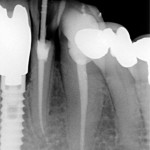
When performing root canal treatment determining the position of the apical constriction of the tooth in order to gauge the ‘working length’ of the root canal is an important step. Traditional this has been performed with radiographs although electronic apex locators (EALs) have been available for may years and are becoming increasingly popular. The aim of this review was to assess the comparative clinical effectiveness of the working length determination with the use of radiographs or EAL.
Searches were conducted in PubMed, LILACS, Science Direct, Cochrane Collaboration, and NHS Evidence databases and in Evidence Based Dentistry (EBD), Journal of Evidence-Based Dental Practice (JEBDP). Randomized controlled trial, clinical trial, diagnostic comparative study, and evaluation studies were selected. Two reviewers independently assessed the articles using CASP worksheets (http://www.casp-uk.net/)
- 21 studies were included, 5 Randomised controlled trials and 16 in vivo diagnostic test studies.
- There was considerable heterogeneity between the EALs used and the study designs and a narrative summary of the findings was presented. Working length measurement was compared using 3 different methods:
- Distance to the radiographic apex in teeth under-going root canal treatment, (11 studies)
- Concordance between the comparative measurements with EAL and radiography, (2 studies)
- Distance to specific anatomic apical reference points evaluated after tooth extraction (4 studies)
The authors concluded
Within the limitations of this review, it is suggested that working length determination by using EAL may perform better than radiography alone.
Comment
As the authors note in their discussion the variable study methodologies made comparisons difficult. This was compounded by the fact that the majority of studies did not directly compare the two techniques. Only 3 of the studies used histology cuts as a ‘gold standard’. In addition most of the included studies has small sample sizes and sensitivity and specificity calculations were not reported. The quality of the available evidence is low and well conducted and high quality studies are needed for in order to provide a more definitive answer.
Links
Martins JN, Marques D, Mata A, Caramês J. Clinical Efficacy of Electronic Apex Locators: Systematic Review. J Endod. 2014 Jun;40(6):759-777. doi: 10.1016/j.joen.2014.03.011. Epub 2014 May 2. Review. PubMed PMID: 24862702.

[…] Dental Elf – 9th Jun 2014 – Electronic Apex Locators may perform better than radiography… […]